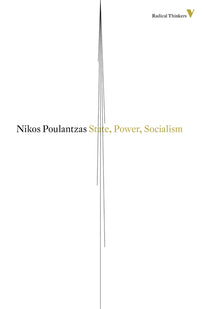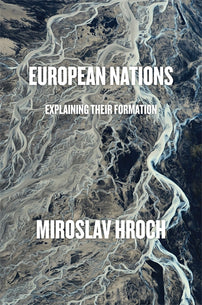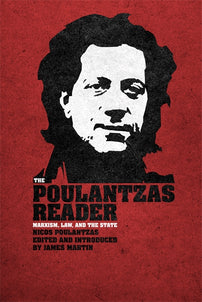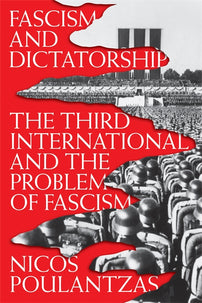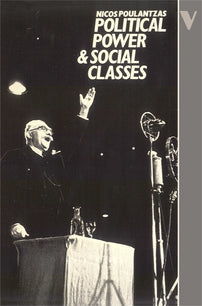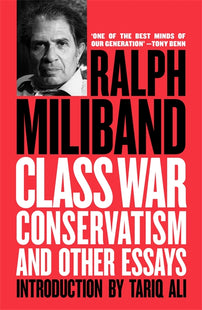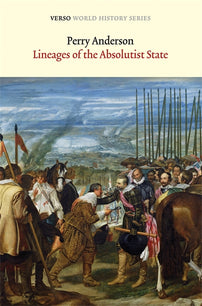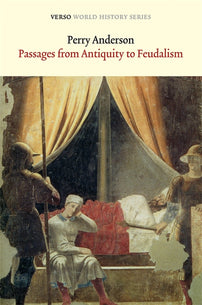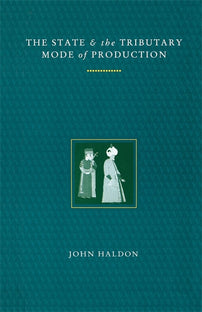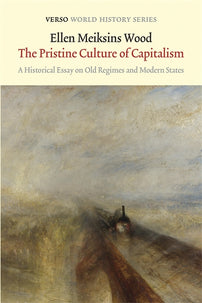States and Stakes: Relational Theory and the Politics of Class Struggle
How we conceive of the state has profound effects on how we understand political strategy. In this essay, written in response to Michael A. McCarthy's recent intervention, Zachary Levenson and Teresa Kalisz argue that only by seeing the state as truly relational can we avoid the pitfall of placing undue emphasis on organising within the state, rather than the vital work of base building.

For the first time in the postwar period, socialism is back on the American political agenda. There are now self-declared socialists elected to multiple major city councils, Congress, and state senates, not to mention contesting the Democratic primary in the last two presidential elections. Polls routinely demonstrate that a majority of Americans under 35 prefer socialism to capitalism, and presidential candidates are regularly asked to express their position on socialism. Major magazines of the liberal intelligentsia like the New Republic, New York Magazine, and Newsweek feature cover stories on the rise of socialism, the New York Times covers a socialist conference on its front page, and conservative and centrist media outlets openly worry about a socialist takeover in the Democratic Party.
While we certainly do not mean to imply that socialists are currently a dominant force on today’s electoral scene, there is still a major opening for such messaging. For the first time in our lives, the idea that socialists could be in charge of at least some aspects of the state is no longer a pipe dream; socialists are consciously coordinating campaigns and actually getting their candidates elected. This then explains the resurgence of debates around state theory, and in particular, a revival of interest in the writing of the Greek Marxist Nicos Poulantzas. In the late 1970s, Poulantzas’ critique of the dual power approach to socialist strategy was highly influential in Eurocommunist circles. Many Communist Party members in France, Italy, and Spain sought a democratic road to socialism that combined the “outside” pressure of social struggles with the “inside” electoral struggle. Now with democratic socialism back on the table, so too are the strategic writings of Poulantzas.
Indeed, not since the last round of debates wrapped up in the early 1980s has there been such a flurry of writing on the state in relation to socialist strategy. Before the 2016 Sanders campaign, there were very few North American Marxists taking these debates seriously – the obvious exceptions being Leo Panitch and Sam Gindin, as well as a special issue of Viewpoint Magazine on the state. Elections for the left are no longer simply about casting a protest vote; we can now viably imagine a self-proclaimed socialist being elected to major national office.
And what are the stakes of these debates today? Simply put, any analysis of the nature of the capitalist state in the current conjuncture necessarily leads to different strategic conclusions. For example, if we were to take an instrumentalist view of the state, conceiving of it as a neutral tool to be wielded by any class whatsoever, we might view electoralism as the best strategy on offer. If the capitalist state is capitalist because it is controlled by capitalists, then our task would be to replace these capitalists with workers. Or if we were instead to take a structuralist view of the state, we might conclude that simply electing socialists would not do the trick. Capitalists would still have the structural leverage to withhold investment in order to force a socialist government to moderate or abandon its program, as occurred in the case of Syriza.
But much as Michael A. McCarthy has argued recently, we reject both of these alternatives. We don’t view the state as a prize to be simply captured (instrumentalists) or rejected (structuralists). Instead, as Poulantzas argued in his 1978 book State, Power, Socialism, we reject formulations that view the state as a “thing” independent of social relations, either as something to be captured or that acts of its own accord – what he identified as the twin pitfalls of Marxist state analysis: “Thing-State” and “State as Subject.” The state isn’t simply some bounded set of pre-existing institutions to be captured by external forces but is instead constituted by these forces. Like Poulantzas then, we take a broader view of socialist strategy vis-à-vis the state. Engagement with the state isn’t about either prioritizing or rejecting elections as the key component of socialist strategy; these sorts of calculations are inseparable from mass protests, strikes, and social movement activity.
[book-strip index="1" style="display"]When we argue that the state is relational, we are highlighting this inseparability. Thinking about the state as relational does not mean that classes relate to an external state apparatus, but rather that relations between classes are inscribed in the very structure of the state. How a unified capitalist class maintains its political domination vis-à-vis all other class fractions is at the heart of the matter. We can’t view this state as what Poulantzas called “a mere appendage of bourgeois domination” because this presupposes the existence of a cohesive capitalist class. Rather, the central role of the state is to organize the various competing fractions of capital – industrial, agrarian, financial, logistical, and so forth – into a dominant social force.
II. McCarthy’s View
In his recent contribution to the Verso blog, McCarthy follows Poulantzas in rejecting the state as either a neutral playing field, as an unreconstructed instrumentalist would have it, or as a unitary subject. “[I]nstead,” he argues, “it is a set of loosely interconnected institutions that are sites of struggle.” Explicitly eschewing the notion that the state is a “thing,” he calls for an analysis of the capitalist state as “a social relation in much the same sense that capital itself is a social relation.” Much like Poulantzas then, McCarthy is pushing back against two theoretical errors. First, he rejects the reformist notion that the state is an empty apparatus that can be deployed in the service of whatever ends its controllers decide, i.e. that the state is inherently class-neutral. And second, he rejects the crude understanding of the state as inextricably tied to the ruling class, i.e. as something which must be smashed. In the latter case, he charges that this iteration of instrumentalist thinking cannot explain the experiences of social democracy, or at least heightened class struggle. And following Fred Block, he correctly points out that were capitalists to control the state directly, they’d be unlikely to fund longer-term prerequisites for accumulation that don’t yield immediate profits – education, infrastructure, R&D, and the like. And besides, without state intervention, capitalists would be unlikely to manage crises and falling rates of profit, as each contending class fraction (if not each contending capitalist!) would attempt to maximize profits immediately.
How then does McCarthy push back against these various forms of instrumentalism? This is where he turns to Poulantzas. Thinking about the capitalist state as a social relation means that class struggles play out on the terrain of the state, a far cry from the notion that this state stands in one-to-one identity with capitalists. And the structural limits he discusses – again, drawing heavily on Block – reveal that the state is hardly a neutral playing field; above all, the threat of capitalists withholding investment places an objective limit on socialist politics being simply legislated (or even executed) into being.
The relational state, he insists, is marked by class struggle playing out in its constitutive institutions. “The upshot of this view,” he explains, “is that while…there are deep biases in the institutions of the capitalist democratic state to govern in favor of the reproduction of capitalism, those biases coexist with opportunities for democratic forces to counter-organize on that same terrain.” Despite these biases, McCarthy argues that the relative autonomy of the state is actually an opportunity: because the state isn’t directly controlled by the bourgeoisie, this gives workers and their allies the chance to get involved in it. Following Claus Offe and Erik Olin Wright, he calls this the “Frankenstein problem”: “While the capitalist democratic state tends to govern for capital, like Frankenstein’s monster it can – and indeed has – become a force out of the capitalist’s control that can wield policy tools once used to reproduce capital against it.” But the state only has sufficient autonomy insofar as its biases aren’t pressuring it too far in either class direction. In other words, in normal periods of democracy, there is a sort of equilibrium between class biases that preserves the opening for proletarian entry into institutions.
III. Who Relates to Whom in the Relational State?
This is where we begin to take issue with McCarthy’s characterization of the capitalist state. To be clear, we fully agree with his opening assertion that this state must be seen as relational. But, as he proceeds, he abandons this conception in favor of a nearly exclusive focus on the state’s relative autonomy, staking his strategic claim on a view of the state in relation to classes not as a power relationship between classes. McCarthy’s capitalist state remains, then, a monolith: a set of interconnected institutions that relate to each respective class, without any relation between classes.
It is precisely this kind of monolithic conception of the state that Poulantzas is arguing against. His “Thing-State” is a unitary entity independent of class struggle to be pressured by one class or the other. Yet, against this, the state’s constitutive institutions have their own internal dynamics and contradictions, and it’s here that we see the full force of the argument against a monolithic state. When Poulantzas argues that class struggle traverses the state, he is insisting that these contradictions are part of that traversal.
But what does it mean to think about class struggle traversing the state? For McCarthy, this largely plays out in terms of contending biases – a model not too far removed from the pluralist conception of the state, a kind of equilibrium in which contending ideas balance each other out, enabling polyarchic democracy. Both classes, he argues, can “influence the policymaking process” by drawing upon certain resources, though of course capitalists have a disproportionate share of these. They can “control and influence politics by hiring legal talent, contributing to campaigns, developing coordinated lobbying efforts, hiring technical consultants, enhancing social prestige and reshaping information available to the electorate,” or in short, waging ideological warfare.
We don’t doubt that the state is deeply biased in the direction of capitalist profitability, but there are two problems with this conception of bias. First, the elevation of lobbying to such a central explanatory role effectively enables individual capitalists, or else specific fractions of capital, to stand in for collective capital in its entirety. Capital in general doesn’t tend to fund campaigns, for example; instead we speak of Wall Street or Big Pharma, or else individual wealthy benefactors. This is a problem because as McCarthy (following Block) argues, individual capitalists are “too short-sighted and concerned with profit making” to ensure longer term economic growth. We fully agree. How then can this explain capitalist bias in general?
Second, this focus on bias reduces the state to its economic functions, to yet another tool in the arsenal of profit-making. But for Poulantzas, the state is not solely a means of economic intervention; its economic functions are inseparable from its political dimensions. It’s not simply that pre-existing class coalitions act upon or through the state, but that the state is an arena in which these alliances are forged, buttressed, destroyed, and everything in between. McCarthy acknowledges this to be the case, but he attributes it to “the dependence politicians have on capitalist investment and the pronounced role of corporate influence in politics.” But again, this puts the cart before the horse, presuming the relative unity of capital. If the state organizes the capitalist class because capitalists (in their unity) will this function into being, then we’re left with a tautology. It also suggests a reconstructed instrumentalist view of the state in which (a) the capitalist state is capitalist because it has been successfully infiltrated by capitalists, and therefore (b) it is a thing to be captured rather than an arena of class struggle.
How then does the capitalist state organize the ruling classes while simultaneously disorganizing the popular classes? First, it acts to consolidate the various contending fractions of capital into a coherent power bloc. It does this by representing the aims of each particular fraction as desirable for all capitalists. We can imagine a situation in which American farmers demand state subsidies in the face of competition from agrarian producers in the global South. But we can also imagine industrial and finance capital opposing such measures, as they might increase their tax payments, or even threaten the ideal of the unfettered market. But by deploying nationalist rhetoric, a government might convince other fractions of capital to concede, recognizing that branding American products as the best on the market could potentially benefit them as well. Taken as one among countless strategies for resolving intra-class contradictions, we can say that all capitalist states work toward unifying fractions of capital into a singular power bloc. Of course, in order to unify certain fractions, it might be strategic to exclude others. We can imagine the exclusion of finance capital in the case of Brexit, or the marginalization of agrarian capital in certain postcolonial contexts. But the point is that rather than taking a unified capitalist class as our point of departure, it is the state that constitutes a power bloc. Following Gramsci, this requires an expanded notion of the state beyond political society proper, including all sorts of think tanks and private organizations that work with the formal institutions of the government to pull off this enormous task, from chambers of commerce to small business administrations.
[book-strip index="2" style="display"]Meanwhile, this state works to disorganize the proletariat. Often this plays out on legislative and judicial terrain. We can think of the Taft-Hartley Act as a key salvo in the battle to disorganize labor, but we could just as easily point to state-level right-to-work laws and Supreme Court decisions from Citizens United to Janus. The point is that the capitalist state isn’t simply biased, but actively works to disorganize any force that could potentially transform its goals.
But don’t these two explanations – bias and dis/organization – go hand-in-hand? Yes, but only with a caveat: by talking about the state as having inherent biases, we are forced to talk about the state in a non-relational way – as a monolith, or a thing. The concept of “biases” renders the state as something external upon which classes exert influence and pressure. As Poulantzas puts it, when “the State is related externally to social classes [it] naturally appears as a montholic bloc without cracks of any kind.” This takes the bourgeois state as a given with a coherent set of biases, and to this end McCarthy can only conceptualize intra-class and institutional contradictions as frictions or breakdowns external to the state. This is best exemplified by his “Frankenstein Problem” in which these contradictions can be capitalized upon to free the monolithic state from capitalist influence to be used against a united capitalist class.
IV. What Does Poulantzas Mean by “Relational”?
For McCarthy then, relationality is between classes and state institutions, i.e. a class is “related” externally to a uniform state. The fact that each class or class fraction competitively exerts its influence upon the state is not at variance with the state’s instrumental unity in this model. To draw on Poulantzas’ imagery, the state isn’t a bed in which each interest group pulls the covers toward itself, arriving at some kind of compromise by default. This kind of tug-of-war is not how he understands the state’s relationality, which remains inextricable from class struggle:
Contrary to concepts that treat it as a Thing or a Subject, the State is itself divided. It is not enough to simply say that contradictions and struggles traverse the State – as if it were a matter of penetrating an already constituted substance or of passing through an empty site that is already there. Class contradictions are the very stuff of the State: they are present in its material framework and pattern its organization; while the State’s policy is the result of their functioning within the State.
And so class struggle is not something that plays out on the terrain of a neutral state; it constitutes the state. There is no stable “thing” called the state that exists independent of the biases McCarthy describes. His opening claim that the “state is not a neutral playing field or a unitary subject” notwithstanding, the concept of “bias” serves to reduce the relationship between capital and the state to one of individual capitalists lobbying for influence upon a fixed terrain. This is capital’s first line of defense, he argues. Through lobbying, networking, and directly funding campaigns – essentially, imparting bias – capital attempts to shore up profitability without compromising its democratic legitimacy.
If this proves ineffective, capital’s second line of defense is to withhold investment, which would catalyze a legitimacy crisis rooted in plummeting business confidence. And of course, when all else fails, there’s always the nuclear option: a capital strike. But in most cases in the contemporary US, this account doesn’t explain the strategies actually deployed by capitalists, who do not rely solely on lobbying and capital mobility to get their way. This sort of explanatory framework presumes the unity of the state, rather than treating it as an inherently divided site of struggle. This is why it doesn’t make sense to talk about the Frankenstein problem as one of the entire state as opposed to a problem of specific institutional locations in that state.
By focusing on the actions and strategies of state administrators, we can begin to identify where and how capitalist political power is expressed and located in the state. This sort of analysis also has implications for any sort of socialist strategy oriented toward the state. As we argue below, a Poulantzian analysis reveals how one of the chief strategies of the power bloc is to shift the institutional location of power beyond the reach of the popular masses. This means that simply augmenting workers’ associational power or even winning electoral victories doesn’t necessarily translate into workers’ power in the long run. In the end, their adversaries can simply shift institutional locations in order to marginalize radical politicians.
Take the example of minimum wage laws. In contesting working class efforts to increase wages, capitalists certainly attempt to impart a certain bias into the state apparatus, scaremongering about the link between wage hikes and job loss. Yet this doesn’t explain gains by fast food workers in cities ranging from those in states with the highest union densities (e.g. Seattle, Washington) to those with the lowest (e.g. Greensboro, North Carolina), as well as those squarely in the middle (e.g. Missoula, Montana). The degree of workers’ associational power did not translate directly into lobbying gains “from below,” so to speak, and this is largely because state administrators shifted the terrain of struggle from sites susceptible to challenge from below to institutional locations in which workers have quite limited influence. For example, in the case of North Carolina, the state preemptively passed a bill preventing any minimum wage increases. In doing so, they successfully shifted the power to make such important policy decisions to institutional locations further removed from mass pressure, i.e. from the municipal to the state level. This rendered the movement, which was initially able to win local minimum wage increases, ineffective in the wake of the shift. Now, in order to achieve comparable gains, increased levels of organization and far greater numbers are required.
Similar shifts have been secured at the state level in Texas in order to preempt local anti-fracking laws from being passed in the city of Denton in the wake of a campaign led by a coalition of activists and NGOs. This shifting of power into institutions at a greater distance from popular classes is not restricted to legislative interference. At the executive level, this played out recently in Michigan, the state with the tenth highest union density in the country (in stark contrast to North Carolina and Texas, which have two of the lowest). A law passed in 1988 formally declared local government a part of state government, which allowed the state government to appoint unelected financial managers to take power in place of actually elected local officials. This created a substantial barrier to popular contestation.
Once taking office in 2011, Governor Rick Snyder’s first act was to update this law, increasing the power of emergency managers, but voters quickly rejected it by a wide margin. In response, Snyder forced through a second version, which included a provision explicitly barring public repeal. These managers retain the ability to, among other things, fire government employees, renegotiate or terminate labor contracts, and privatize local assets. In addition, the ability of managers to raise taxes is explicitly circumscribed. By shifting the terrain of struggle from the municipalities to the state level, “the popular masses are physically excluded from certain apparatuses,” as Poulantzas puts it.
These examples, while extreme, demonstrate how it is not just policy itself, but who gets to make this policy, that is ultimately a question of class struggle. This shifting of power from one set of institutional locations to another in response to popular pressure is a manifestation of class struggle unfolding upon the terrain of the state. If we were instead to examine these struggles from the perspective McCarthy presents, we would expect that local minimum wage or anti-fracking laws would not have passed at all given the extremely low levels of associational power in both cases, not to mention the absence of left-wing elected officials. And in the unlikely case that they did pass, or even come close to passing, capital would rein in local officials by threatening to run primary challengers, or else to relocate business and withhold future investment.
We would not however, expect within McCarthy’s framework to see other state institutions stepping in, or else frontal assaults on democracy. Even if he were to allow for this addition, it would remain just that: an auxiliary aspect of the theory rather than constitutive of his fundamental understanding of the capitalist state. But if we see the state as a power relation between classes (rather than between the Thing-State and classes), we can see these shifts as attempts to limit or undermine popular power. In other words, Poulantzas’ relational framework allows us to view a broader picture of struggle rather than capitalists acting individually to discipline state officials who make concessions to workers.
[book-strip index="3" style="display"]But in the US, the proletariat has extremely limited sway. With no labor party currently or historically, as well as outrageously low union density levels, the working class can’t currently make inroads into affecting state policymaking. Certainly we were heartened to witness the greatest number of strikes in the US since the 1980s last year, and above all, the teachers’ strike wave, but we must also note that these largely occurred in a public sector that is both shrinking and deunionizing. Any analysis of the balance of class forces in the current conjuncture needs to make a realistic assessment of our current power. McCarthy is on to something when he suggests,
As the composition of the economy is shifted away from employment in capitalist firms toward public employment and workplace democracy, and the people are less dependent on international financial constraints and freed from imperialist modes of international relations, the structural power of capital in the capitalist democratic state will weaken relative to that of other classes.
But there’s a glaring problem with this statement: it occurs in the same section in which he argues, “We can only understand the state tactically by analyzing it conjuncturally.” Yet this is not a conjunctural analysis, but rather a normative injunction, a deep-seated wish for an expanded public sector characterized by augmented workers’ power. But if this sort of conjuncture is a necessary precondition for transforming “a deeply biased set of institutions,” then how should we think about socialist strategy in a conjuncture notable for its degree of power asymmetry?
This is why Poulantzas characterizes the capitalist state during the birth pangs of neoliberalism as authoritarian statism. This is a period of regroupment in which states establish “an entire institutional structure serving to prevent a rise in popular struggles and the dangers which that holds for class hegemony.” Such an increased political role for the state tends to occur against the backdrop of economic crisis, which typically heightens contradictions within the power bloc. For example, large sections of American capital opposed Obama’s TARP program on the grounds that it simply redirected public funds to Wall Street at their expense. But by uniting around a program of worker repression, authoritarian statism reconstitutes the power bloc and reproduces bourgeois hegemony.
V. Strategic Implications
Why does any of this hair-splitting matter in relation to socialist strategy? What are the real material stakes of this debate? Insofar as a strategy underpins McCarthy’s intervention, he appears to follow Poulantzas to the final chapter of State, Power, Socialism in which he rejects any attempt to smash the state as misguided, instead opting to transform it from within:
Transformation of the state apparatus tending toward the withering away of the State can rest only on increased intervention of the popular masses in the State: certainly through their trade-union and political forms of representation, but also through their own initiatives within the State itself.
This alone of course is insufficient:
This process should be accompanied with the development of new forms of direct, rank-and-file democracy, and the flowering of self-management networks and centres.
So a Poulantzian strategy for shifting the balance of power in favor of workers would require organized workers to intervene from within, as well as self-organized workers to do so from without.
But in the current conjuncture, with historically disempowered workers in the US, from where would these twin forces emerge? The election or viable campaigns of a handful of left-wing candidates in national, regional, and citywide contests are no substitute for increased working-class capacity and radicalism. Others cite recent polls revealing that 40 percent of Americans (and a majority of millennials) prefer socialism to capitalism, and like them, we cheer these results, but we can’t mistake them for associational power. Since the Sanders campaign launched in 2015, socialism has been largely articulated in terms of a strategy that serializes workers, to borrow Sartre’s term. In Critique of Dialectical Reason, he describes people who are serialized as “united though not integrated through work, through struggle or through any other activity in an organised group common to them all” – in short, as “reciprocal isolations.” Despite the promise of augmenting working class organizational capacity, a Sartrean “series” is the sort of unity produced by electoralism. Rather than building collective power through the recognition of common material interests, let alone a struggle that requires strategic coordination, electoralism articulates socialism as a project of deferral. The only thing each worker has in common with the rest of their class is that they are all campaigning or voting in simultaneity. Each voter relates to the candidate, but rarely to one another. Certainly some degree of organization emerges in relation to the campaign, but these are largely volunteers and political operatives – quite different from proletarians. This isn’t class action, but actions carried out by members of a class. The difference is crucial.
Since this version of socialist strategy ultimately individualizes instead of building collective capacity, it fails to constitute any transformative force, however incrementally. To translate this into McCarthy’s terms, it doesn’t unite labor with political struggles in order to force a reversal of bias at the level of the state. Nor does it lay a foundation for the sort of working-class engagement in the state described by Poulantzas, let alone his new forms of rank and file democracy that he positions as vital to the transformation of society and the state. By recognizing these strategic limits of the current conjuncture, what’s on the table is the question of how we build a basis for developing precisely the working-class power that McCarthy’s wants, but in a way that’s not serialized.
Moreover, to view our present moment as one marked by a question of necessarily counteracting state biases, either through electoral means or strike action, is to misunderstand the demands of this moment. Many of the contributions to the current round of the state debate train their critical eye on what, following Poulantzas, they dismiss as “dual power” strategies, i.e. building collective power in proletarian organs independent from (and opposed to) the capitalist state. Instead, they argue for “organiz[ing] upon, challeng[ing], and transform[ing the capitalist state] both from inside and out,” whether because they perceive the electoral road to be the only one currently legitimate in the eyes of workers, or because they see contradictions internal to the state as openings for incursion. But both of these approaches, dual power and inside/outside strategy, are founded upon the presence of a militant and well-organized working class.
The point then isn’t to build a better campaign that mentions socialism more frequently or appeals to a broader cross-section of workers. The extent to which we could even potentially refer to this strategy as “class struggle social democracy” would rely upon – surprise, surprise! – class struggle. The extent to which a certain strategy embodies “class struggle” isn’t dependent upon the rhetoric of its leaders or its calls for mass action disarticulated from a base. Unless such a strategy can build real independent working-class organization and democracy, then it doesn’t stand a chance. And this means that whatever our preferred strategy, dual power, electoralist, or otherwise, base-building is its necessary precondition. In practice this means:
- Organizing the unorganized;
- Building militant workplace and community organizations;
- Engaging the state in a way that expresses class-wide power, not in ways that work to further serialize the proletariat; and
- Finding ways to hold state actors and above all, self-proclaimed socialist representatives, accountable to the broader movement, including (but not limited to) anti-gentrification mobilization, fighting against the oppression of immigrants, demanding reproductive justice, and challenging police brutality.
Every one of these strategies builds working-class power rather than deferring it through delegation. Once we have an organized working class in this country, we can talk about building the basis for some of the strategies that Poulantzas described in State, Power, Socialism. While we remain averse to even Eurocommunism’s leftwing iterations (a critique which is beyond the scope of this essay), at least Poulantzas based his strategy on the thoroughly organized working classes of France, Spain, and Italy in the 1970s, as well as independent Communist parties in each respective national context. Speaking frankly, there is no rough parallel in the US today, with union membership at its lowest level since the passage of Taft-Hartley. We were certainly heartened to read that there were more work stoppages last year than in any other since 1986, but we also need to place this statistic in context: before 1984, no year saw as few stoppages as 2018 since the end of World War II.
This is why we need to take the current conjuncture so seriously. In the US today, we see an increasingly authoritarian state waging an intensive struggle against an important and oppressed section of the working class; a disorganized working class that’s only now starting to increase its militancy, however incrementally; self-proclaimed socialists in elected office of varying militancy; increasingly nationalist and protectionist trade policies; and the beginnings of a conservative backlash against progressives’ proposed social policies. This isn’t our attempt to play the pessimists, but rather to assess our current moment in both conjunctural and sober terms. Without doing so, we risk further serializing the working class we do have, deferring hope to charismatic leaders, and ultimately provoking a backlash without possessing the class forces to successfully fight back. This is why base building, rather than organizing within the state, is key to the present moment. Unless proponents of organizing within state institutions can demonstrate how these strategies build popular organizational capacity, we remain concerned that this approach posits a parliamentary road without any corresponding party or class base.
Zachary Levenson is a sociologist at the University of North Carolina, Greensboro.
Teresa Kalisz is an organizer based in New York City and a member of Red Bloom and the Marxist Center.
[book-strip index="4" style="display"]
